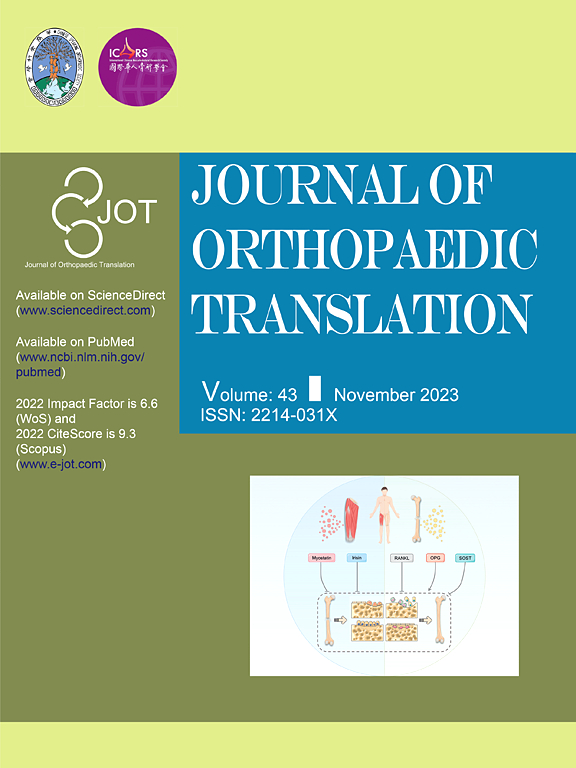Hip joint-preserving strategies for treating osteonecrosis of the femoral head: From nonoperative to operative procedures
IF 5.9
1区 医学
Q1 ORTHOPEDICS
引用次数: 0
Abstract
Osteonecrosis of the femoral head (ONFH) has an exceedingly high prevalence and disability rate, causing a tremendous socioeconomic burden. The prevalence of ONFH is increasing, while the population of the patients with ONFH is becoming younger. Once the femoral head collapses, treatment becomes difficult and often requires a hip joint replacement, which is not favorable for young patients. Therefore, hip joint-preserving treatments at an early stage of ONFH are particularly important. This study provides a comprehensive review on hip-preserving strategies for treating ONFH, including nonoperative treatments (e.g., protective weight bearing, hyperbaric oxygen, pulsed electromagnetic, extracorporeal shockwave, bisphosphonate, anticoagulants, hypolipidemics, vasodilators, and traditional Chinese medicine) and operative treatments (e.g., core decompression, osteotomy, bone grafting, mesenchymal stem cell transplantation, tantalum rods, and tissue engineering). Nonoperative treatments aim to slow down the progression of the disease and delay the need for joint replacement; however, they usually cannot effectively prevent the progression of the disease, except in cases of small necrosis areas (<10 %). Additionally, nonoperative treatments have unclear mechanisms that require further investigation. In contrast, operative treatments may stop the negative outcomes of necrosis and therefore appear to be more promising. Currently, an emerging area in operative treatments is regenerative medicine, which could promote the generation of bone tissues and blood vessels and restore hip joint function to pre-necrotic levels as much as possible. This review seeks to not only provide an important reference for clinicians when choosing appropriate strategies for treating ONFH but also offer certain guidance for future basic research in developing ONFH treatments.
The translational potential of this article
The incidence of ONFH is increasing, and patients are becoming younger on average. Therefore, the development of hip joint-preserving strategies to treat ONFH at earlier stages is urgently needed, particularly for young patients. However, a comprehensive review is lacking regarding the currently-available hip joint-preserving strategies and their effectiveness. This study is motivated to fill this gap and serve as an important reference for clinicians in choosing appropriate strategies to treat ONFH.

治疗股骨头坏死的髋关节保护策略:从非手术到手术
股骨头坏死(ONFH)具有极高的患病率和致残率,造成了巨大的社会经济负担。ONFH的患病率呈上升趋势,而ONFH患者的人群呈年轻化趋势。一旦股骨头塌陷,治疗变得困难,通常需要髋关节置换术,这对年轻患者不利。因此,早期ONFH的髋关节保留治疗尤为重要。本研究全面综述了治疗ONFH的保髋策略,包括非手术治疗(如保护性负重、高压氧、脉冲电磁、体外冲击波、双膦酸盐、抗凝血药、低血脂药、血管扩张剂和中药)和手术治疗(如核心减压、切骨、植骨、间充质干细胞移植、钽棒和组织工程)。非手术治疗的目的是减缓疾病的进展,推迟关节置换术的需要;然而,它们通常不能有效地阻止疾病的进展,除非是小坏死区域(10%)。此外,非手术治疗的机制尚不清楚,需要进一步研究。相比之下,手术治疗可能会阻止坏死的负面结果,因此看起来更有希望。目前,手术治疗的一个新兴领域是再生医学,它可以促进骨组织和血管的生成,并尽可能地将髋关节功能恢复到坏死前的水平。本综述旨在为临床医生选择合适的ONFH治疗策略提供重要参考,同时也为今后ONFH治疗方法的基础研究提供一定的指导。ONFH的发病率正在增加,而且患者的平均年龄越来越小。因此,迫切需要在早期阶段发展髋关节保护策略来治疗ONFH,特别是对于年轻患者。然而,对于目前可用的髋关节保留策略及其有效性缺乏全面的综述。本研究旨在填补这一空白,为临床医生选择合适的治疗策略提供重要参考。
本文章由计算机程序翻译,如有差异,请以英文原文为准。
求助全文
约1分钟内获得全文
求助全文
来源期刊

Journal of Orthopaedic Translation
Medicine-Orthopedics and Sports Medicine
CiteScore
11.80
自引率
13.60%
发文量
91
审稿时长
29 days
期刊介绍:
The Journal of Orthopaedic Translation (JOT) is the official peer-reviewed, open access journal of the Chinese Speaking Orthopaedic Society (CSOS) and the International Chinese Musculoskeletal Research Society (ICMRS). It is published quarterly, in January, April, July and October, by Elsevier.
 求助内容:
求助内容: 应助结果提醒方式:
应助结果提醒方式:


